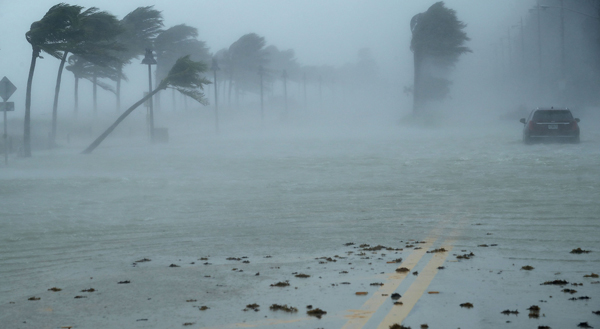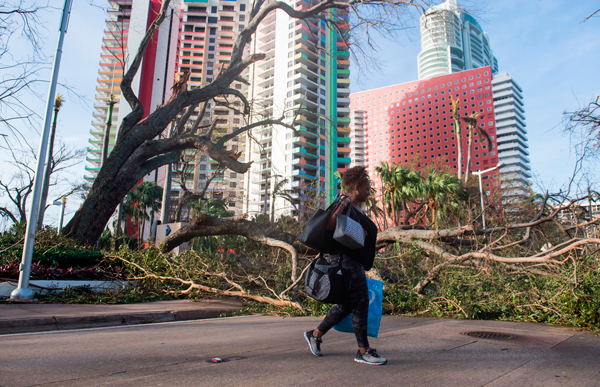Trending
Rebuilding after Irma

Hurricane Irma has moved on. The winds have died down. The waters have receded. The lights are back on.
Barreling through the Caribbean as a Category 5 monster — resulting in 42 storm-related deaths — Irma also knocked out power for millions and did billions of dollars’ worth of damage to Florida on September 10.
Just one week after the hurricane’s rampage through the state, storm-related insurance claims filed had already reached an estimated $2 billion in losses, according to Florida’s Office of Insurance Regulation. The final totals will likely range from $20 to $40 billion, according to an estimate from catastrophe modeling firm AIR Worldwide. The company estimated that exposure value in counties running along the Gulf Coast up to Tampa — the area hit hardest in the U.S. — would reach $1 trillion.
The estimates do not include losses to uninsured properties, infrastructure or pleasure boats, or losses that would be paid out by the National Flood Insurance Program.
About 25 percent of homes in the Florida Keys were destroyed after Hurricane Irma barreled through the islands, according to estimates by the Federal Emergency Management Agency.
In the wake of the storm, Gov. Rick Scott signed an emergency order that gives homeowners insurance policyholders an additional 90 days to supply information to their insurance companies and file claims.
While the cost of devastation to the area is huge, experts from across the real estate world told The Real Deal that building codes enacted after Hurricane Andrew in 1992 allowed the 6 million people in metro Miami to weather the storm in relative safety.
Even in its weakened state, Hurricane Irma highlighted how far South Florida has come in preparing for natural disasters in the last 25 years while also revealing how much more needs to be done in the future.
“It’s fair to say that Miami did not see the maximum wind speed that we have designed for,” Jean-Pierre Bardet, the dean of engineering at the University of Miami, said. “So my question is: Have we seen a real test of our code and practices? Maybe not.”
Assessing Irma’s impact
Just under $40 billion of CMBS debt was exposed to the wrath of Hurricane Irma in Florida, $6.41 billion of which was concentrated in Miami, according to an analysis from Morningstar Credit Ratings.
Stunning pictures captured the severe flooding in Brickell and Coconut Grove, two neighborhoods that have seen major development this real estate cycle.
 “The areas that flooded we expect to flood, and most of the buildings are sort of built to accommodate that. The recovery from it is very rapid because of that,” Jeremy Calleros Gauger, deputy director of Miami Planning and Zoning, said.
“The areas that flooded we expect to flood, and most of the buildings are sort of built to accommodate that. The recovery from it is very rapid because of that,” Jeremy Calleros Gauger, deputy director of Miami Planning and Zoning, said.
Some developers stayed in place to keep watch over their properties. Carlos Melo, co-founder and principal of the Melo Group — which has developed 12 condo and apartment towers in Miami’s Edgewater, Little Havana and Allapattah neighborhoods — said he weathered Irma at his corporate office at 425 Northeast 22nd Street.
“We had about 1 foot of water at ground level,” Melo said. “It only affected the parking area, but it never reached the building. And about an hour and a half after the hurricane passed, the water had receded.”
Miami architect Kobi Karp left for New York City before the storm, flying back to Miami on a 6 a.m. American Airlines flight on Tuesday, Sept. 12. In the meantime, he arranged for his Biscayne Boulevard office to be back up and running with a generator and air conditioning.
“We’re pretty well cultured in hurricanes and tropical storms at this point, and we try not to have any downtime,” Karp said. By Thursday, he said, most of his staff of 85 was back in the office.
Some of the construction cranes that help power the metro area’s building boom did not fare as well. Irma took one out at Property Markets Group’s 300 Biscayne Boulevard development in downtown Miami, and another crane collapsed at the Related Group’s Gran Paraiso condo tower at 480 Northeast 31st Street. A third crane fell at Related’s Auberge Beach Residences and Spa in Fort Lauderdale.
The collapses expose a gap in oversight, Gauger said. “The cranes are basically only regulated by OSHA, which is to say only regulated for worker safety, not for structural integrity or anything else,” he said. “They are completely self-regulated by law, not by any lack of attempts by the state or county or the city to regulate them in the past. They are treated the same way as scaffolding or a wheelbarrow.”
Recovery and rebuilding
Cleanup and rebuilding efforts have already begun. FEMA has declared 37 counties in Florida eligible for federal disaster assistance, with Miami-Dade, Broward and Palm Beach among them.
The biggest problem that will arise in the rebuilding effort, according to the Florida Home Builders Association (FHBA), is a lack of qualified workers to do the fixing.
“Talk to any builder or any tradesman across the United States right now, and they will tell you that there’s a workforce issue,” said Jeremy Stewart, president of the FHBA. “This is going to get compounded with the storm and the availability of actually getting boots on the ground to get things cleaned up.”
Miami-based developer Lennar Corporation announced after the storm that 700 home deliveries in Florida, Georgia and South Carolina would be delayed from its fiscal fourth quarter to the next fiscal year.
“It will impact new starts; there’s no ifs, ands or buts about it,” Stewart told TRD.
But there will be pockets of real estate activity in the short term, experts said. Nancy Klock Corey, Coldwell Banker’s regional vice president for the Southeast Florida region, said that some sectors of the market will see a boost after the storm. “Short-term rentals will be pretty hot,” she said. “As properties are renovated and restored, there will be very high demand for these types of rentals.”
And while the recovery efforts could cause a spike in construction, total economic recovery will take much longer. The fallout from Harvey and Irma combined could reduce U.S. economic growth in the third quarter to an annual rate of 1.8 percent, down from the 2.8 percent growth projection, the Wall Street Journal reported.

Debris remained scattered on Brickell Avenue on Sept. 11.
For some small businesses, however, there will be no recovery. Epicure Gourmet Market & Café in Miami Beach, for instance, announced its closure a week after the storm, citing Hurricane Irma, “problems with storm insurance” and declining sales.
The rewards of precaution
But, of course, Florida knows how much worse it could have been. Twenty-five years ago, Hurricane Andrew decimated the area. Making landfall as a Category 5 storm, Andrew destroyed 25,000 homes in the state, damaging 100,000 more and creating $26.5 billion in economic losses. Hurricane Andrew’s lasting effect, however, is evidenced in the massive upgrades that were made to the building code.
Before Andrew, there were as many as 26 varying building codes across Florida, and they were unevenly enforced, insiders said, which explains why the storm was so destructive. After Andrew, the Florida Building Code was established to hold the state’s housing stock to the strongest protections possible against storm-force winds, according to Shahid Hamid, a Florida International University (FIU) professor, who works primarily on the financial and insurance consequences of hurricanes.
In the years since Andrew, the state has also mandated stronger building materials and construction methods. House roofs now need a stronger tie-in to the buildings’ structure. Plywood must be used instead of weaker particle board, and roofing nails are required instead of staples. All buildings need to have either storm shutters or impact-resistant glass. “When we talk about post-Hurricane Andrew, it’s not just that the building code got tight,” Stewart of the FHBA said. “The regulations as far as contractors and licensers got tight.”
The insurance market was stabilized as well. The Florida Hurricane Catastrophe Fund was created by the legislature in 1993 to backstop private insurance for possible disasters in the state. The public-private partnership offers reinsurance for Florida’s insurers, which allows multiple insurance companies to share risk and limit the total losses of an insurer in case of disaster. At the beginning of the 2017 storm season, it had $17 billion in its coffers. “It could have been tempting to not preserve that much money and just have it sitting there, but Florida leaders have been very prudent,” said Leslie Chapman-Henderson, president and CEO of the nonprofit Federal Alliance for Safe Homes.
Curing hurricane amnesia
Before Irma, it had been 12 years since a major storm hit Florida, and some worried that the run of blue skies was helping people forget the ever-present danger.
“The best actions are usually taken shortly after an event, when everybody is concerned and have actually experienced for themselves the forces of nature,” said the University of Miami’s Bardet. “So it’s an amazing decay of memory that we have, a tendency to forget things and to become complacent as time goes by.”
Despite the strengthening of the building code — and advancements in weather prediction technology — South Florida will continue to be under threat from Atlantic storms. As sea levels rise, the threat of flooding due to storm surges — which has been a major issue for years — becomes even more pronounced.
And these days, significantly more people and buildings are in the path of those storms and floods. Miami-Dade County has grown 35 percent since Andrew in 1992 and is projected to add another million people by 2045.
Many of those people will live in recently built multifamily towers, which were not as prevalent during Andrew. While those towers are engineered to withstand 140 to 150 mph winds, they face other challenges.
“With the condominiums, the high-rises, the structure is going to hold up — you might have some window breaches and so on — but the real damage is going to be through water infiltration,” FIU’s Hamid said. During hurricanes Wilma and Charley, he noted, towers in Melbourne (just southeast of Orlando) suffered what appeared to be minor damage but ultimately were condemned because water irretrievably damaged the interiors of the buildings.
Warning flags were raised among emergency preparedness experts in June when Gov. Scott, with the support of the FHBA, signed a bill that changed the way the state’s building code is updated. Previously, the Florida Building Commission automatically updated the code with the latest version from the International Code Council, removing any items not relevant to Florida, such as snow load. Under the new law, Florida authorities will review the new versions and choose which sections to add.
“We had hurricane amnesia from a policymaker standpoint, because the policymakers who created things like the My Safe Florida Home [a program giving homeowners access to free wind inspections] would have never, ever, ever, ever weakened the building code,” said Chapman-Henderson.
But the FHBA’s president said that the bill it supported would only streamline the process. “Nothing in the bill changes the Florida building code, nor does it change the policies or changes that went into effect post-Hurricane Andrew,” Stewart said. “We are still going to have the Florida Building Code; then every three years we’re going to review the newest version of the ICC for implementation into the code.”
Changes for the future
Experts and local officials tell TRD that while risk is unavoidable, action must be taken now to strengthen vulnerable infrastructure in the face of stronger storms and rising sea levels.
Miami-Dade County, the City of Miami and Miami Beach have joined together in a program called Resilient Greater Miami & the Beaches and have been selected to join 100 Resilient Cities, a national nonprofit sponsored by the Rockefeller Foundation that helps urban centers prepare “physical, social and economic challenges that are a growing part of the 21st century,” according to its mission statement.
In January, Miami Beach launched a $100 million plan to install floodwater pumps, rebuild sewers and raise the level of its streets. In November, Miami residents will vote on a $400 million bond issue proposed by Mayor Tomás Regalado that will fund similar efforts. “Even if we didn’t have sea level rise, we’d have some catching up to do in terms of stormwater and drainage,” Jane Gilbert, chief resilience officer for the City of Miami, said. “The city has a lot to do to upgrade its infrastructure.”
For real estate developers, resilience means not only safe buildings but siting them on safe land. “Right now, the thing that really drives the bus is the FEMA flood elevation levels map,” Gauger of Miami’s planning board said. “The developers definitely respond, and they want to sell a product that is safe and insurable.”
— Francisco Alvarado, Ina Cordle, Katherine Kallergis, Richard Murdocco, Amanda Rabines and Mike Seemuth contributed to this report.




